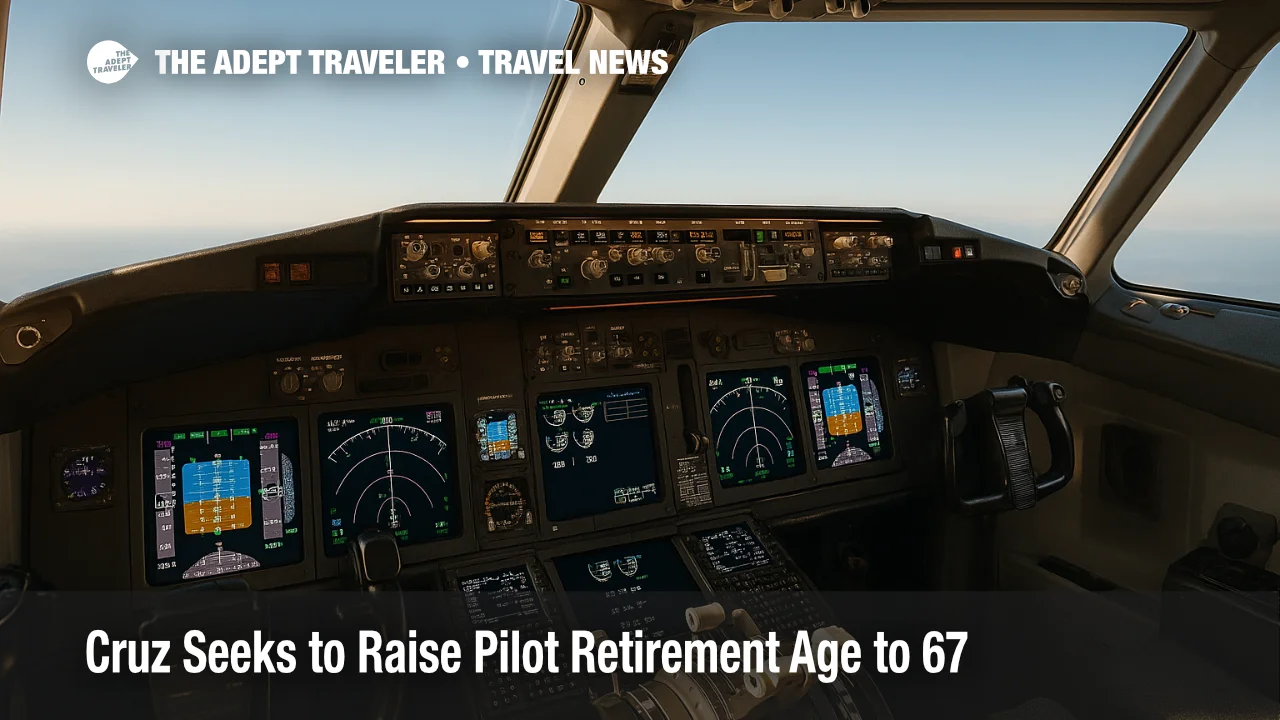Senator seeks to raise pilot retirement age to 67

Senator Ted Cruz, the Republican chair of the Senate Commerce Committee, is urging President Donald Trump to back a global move raising the pilot retirement age to 67, or to abolish it entirely. His letter, sent ahead of the International Civil Aviation Organization Assembly in Montreal, argues that the current limit of 65 forces experienced aviators into retirement. Airlines, through IATA, say a science-based increase would not compromise safety. Pilot unions, led by ALPA, counter that shifting the limit without rigorous study would increase risk.
Key Points
- Why it matters: Changing the pilot retirement age affects staffing, schedules, and international compliance.
- Travel impact: U.S. pilots over 65 could not fly abroad unless ICAO changes its 65-year standard.
- What's next: ICAO delegates meet in Montreal the week of September 23, 2025, to consider IATA's proposal.
- Stakeholders: IATA supports a move to 67 with medical safeguards; ALPA urges Congress to hold the line at 65.
- Regulatory context: FAA previously told Congress any change must follow a scientific safety analysis.
Snapshot
On September 21, 2025, Senator Ted Cruz asked President Trump to endorse raising, or even eliminating, the pilot retirement age as countries gather at ICAO's Assembly in Montreal. IATA backs lifting the international limit for multi-pilot airline operations from 65 to 67, paired with stricter, standardized medical oversight and a requirement that one pilot be under 65. ALPA, the largest U.S. pilot union, rejects the plan, citing safety and regulatory disruption if the United States moves out of step with global standards. Congress declined to raise the domestic age in 2024 after the FAA called for science-based review. Any unilateral U.S. increase would still collide with ICAO rules that bar over-65 pilots on international routes.
Background
The global upper age for airline pilots on multi-pilot international flights is set by ICAO at 65 under Annex 1. Many countries, including the United States, mirror that limit in domestic regulations for scheduled air carriers. The United States last changed its rule in 2007, when it moved from 60 to 65 following ICAO's shift. In the 2024 FAA reauthorization debate, a House-backed plan to lift the U.S. limit to 67 did not survive, after the FAA signaled that safety evidence must precede any change. IATA now argues medicine and longevity gains justify a careful increase. Unions counter that higher age could raise medical risks, complicate crew scheduling, and disrupt collective bargaining agreements.
Latest Developments
Cruz presses the White House as ICAO weighs a 67-year limit
Cruz's letter frames the moment as a leadership test for the United States, urging the administration to support raising, or abolishing, the pilot retirement age during the ICAO Assembly starting September 23, 2025. Reuters reports IATA's paper seeks a move to age 67 for multi-pilot operations, retaining the safeguard that at least one pilot remain under 65, along with tighter, standardized medical checks. Several states are said to be open to the change. The White House has not taken a formal position. If ICAO adopts a new standard, members could align national rules, easing cross-border scheduling and reducing the risk of crews timing out due to age limits mid-network.
Unions and regulators emphasize safety evidence
ALPA reiterated its opposition on August 28, 2025, warning that a unilateral U.S. shift would violate international standards and upend airline operations. The union points to increased medical and cognitive risks as pilots age, and to years of analysis that preceded the 2007 move to 65. The FAA in February 2024 told Congress that any change should follow a scientific safety analysis, a position that helped sink the 67-year proposal in the last reauthorization cycle. Without an ICAO change, U.S. pilots over 65 would remain restricted from international legs, limiting any domestic-only policy's operational value for global carriers.
Analysis
For travelers, the issue is less about who sits up front next week and more about medium-term network flexibility. Raising the pilot retirement age to 67 could modestly slow retirements, helping airlines retain seasoned captains while new pilots advance. That might ease training bottlenecks, reduce overtime costs, and steady schedules on thinner routes. The benefit is constrained, however, unless ICAO moves in lockstep. Airlines cannot roster over-65 pilots on international sectors today, so a U.S.-only increase would create complex pairing rules and less efficient crew utilization.
Safety is the fulcrum. ICAO's 2007 shift to 65 followed broad medical review and an under-65 pairing rule to mitigate risk. IATA's current proposal mirrors that risk management approach, adding standardized, more frequent medicals. ALPA's skepticism focuses on data sufficiency and practical impacts on contracts, training pipelines, and insurance. Policymakers must weigh incremental staffing gains against the cost of medical oversight and transitional disruptions. A coordinated ICAO update, if supported by transparent evidence and clear safeguards, would minimize fragmentation and deliver most of the upside with fewer operational penalties. If the Assembly defers, expect the United States to hold at 65 pending further study.
Final Thoughts
Travelers should not expect immediate changes, even if debate heats up in Montreal this week. Any shift requires global alignment through ICAO and subsequent national rulemaking, with medical protocols and crew-pairing safeguards. Airlines favor flexibility, unions prioritize safety and contract stability, and regulators want solid evidence. Until those pieces align, your flight deck remains staffed under the current pilot retirement age.
Sources
- Key US senator urges Trump to back older retirement age for pilots, Reuters
- Global airlines group proposes raising international pilot retirement age to 67, Reuters
- Pilot Age Limits, IATA
- Statement on IATA attempts to raise the pilot retirement age, ALPA
- FAA tells Congress not to raise the mandatory retirement for pilots until it can study the issue, PBS NewsHour
- Pilot age limit, crew pairing requirement, Federal Register
- Proposal to raise multi-pilot commercial air transport age limit, ICAO Working Paper
- ALPA opposes IATA's push for 67-year pilot retirement age, FlightGlobal
